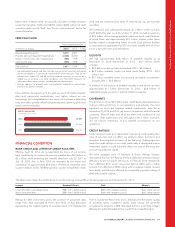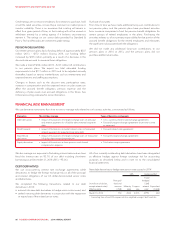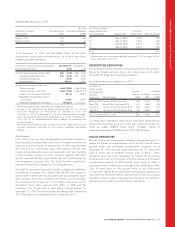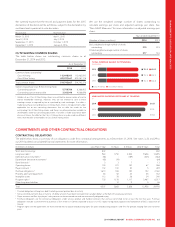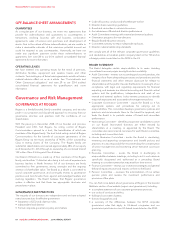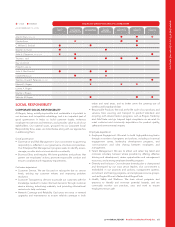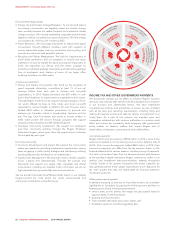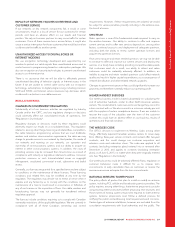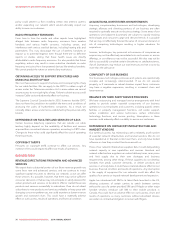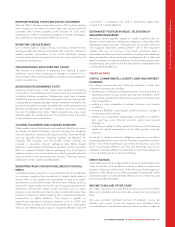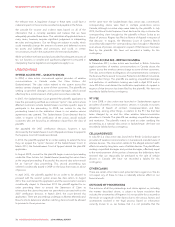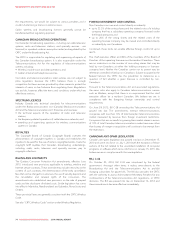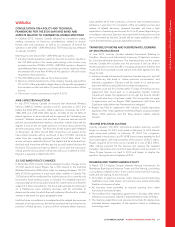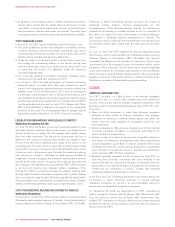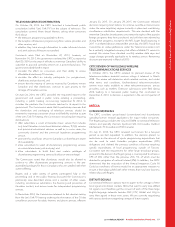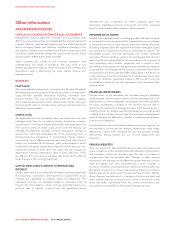Rogers 2014 Annual Report Download - page 73
Download and view the complete annual report
Please find page 73 of the 2014 Rogers annual report below. You can navigate through the pages in the report by either clicking on the pages listed below, or by using the keyword search tool below to find specific information within the annual report.
MANAGEMENT’S DISCUSSION AND ANALYSIS
IMPACT OF NETWORK FAILURES ON REVENUE AND
CUSTOMER SERVICE
If our networks or key network components fail, it could, in some
circumstances, result in a loss of service for our customers for certain
periods and have an adverse effect on our results and financial
position. We rely on business partners to carry some traffic for certain
customers. If one of these carriers has a service failure, it might also
cause a service interruption for those customers that would last until we
could reroute the traffic to another carrier.
UNAUTHORIZED ACCESS TO DIGITAL BOXES OR
INTERNET MODEMS
We use encryption technology developed and supported by our
vendors to protect our cable signals from unauthorized access and to
control access to programming based on subscription packages. We
also use encryption and security technologies to prevent unauthorized
access to our Internet service.
Thereisnoassurancethatwewillbeabletoeffectivelyprevent
unauthorized decoding of television signals or Internet access in the
future. If we are unable to control cable access with our encryption
technology, subscriptions to digital programming, including premium
VOD and SVOD, and Internet service revenues may decrease, which
could result in a decline in our cable revenues.
REGULATORY RISKS
CHANGES IN GOVERNMENT REGULATIONS
Substantially all of our business activities are regulated by Industry
Canada and/or the CRTC, and any regulatory changes or decisions
could adversely affect our consolidated results of operations. See
“RegulationinOurIndustry”.
Regulatory changes or decisions made by these regulators could
adversely impact our results on a consolidated basis. This regulation
relates to, among other things, licencing and related fees, competition,
the cable television programming services that we must distribute,
wireless and wireline interconnection agreements, the rates we may
charge to provide access to our network by third parties, the resale of
our networks and roaming on our networks, our operation and
ownership of communications systems and our ability to acquire an
interest in other communications systems. In addition, the costs of
providing services may be increased from time-to-time as a result of
compliance with industry or legislative initiatives to address consumer
protection concerns or such Internet-related issues as copyright
infringement, unsolicited commercial e-mail, cybercrime and lawful
access.
Generally, our licences are granted for a specified term and are subject
to conditions on the maintenance of these licences. These licencing
conditions and related fees may be modified at any time by the
regulators. The regulators may decide not to renew a licence when it
expires, and any failure by us to comply with the conditions on the
maintenance of a licence could result in a revocation or forfeiture of
any of our licences or the imposition of fines. Our cable, wireless and
broadcasting licences may not generally be transferred without
regulatory approval.
The licences include conditions requiring us to comply with Canadian
ownership restrictions of the applicable legislation. We are currently in
compliance with all of these Canadian ownership and control
requirements. However, if these requirements are violated, we would
be subject to various penalties, possibly including, in the extreme case,
the loss of a licence.
SPECTRUM
Radiospectrumisoneofthefundamentalassetsrequiredtocarryon
the wireless business. Our ability to continue to offer and improve
current services and to offer new services depends on, among other
factors, continued access to and deployment of adequate spectrum,
including both the ability to renew current spectrum licences and
acquire new spectrum licences.
If we cannot acquire and retain needed spectrum, we may not be able
to continue to offer and improve our current services and deploy new
services on a timely basis including providing competitive data speeds
that customers want. As a result, our ability to attract and retain
customers could be materially adversely affected. In addition, an
inability to acquire and retain needed spectrum could affect network
quality and result in higher capital expenditures, as a consequence of
network densification and other related network upgrades.
Changes to government spectrum fees could significantly increase our
payments and therefore materially reduce our operating profit.
HIGHER HANDSET SUBSIDIES
Our wireless business model is based substantially on subsidizing the
cost of subscriber handsets, similar to other North American wireless
carriers. This model attracts customers and in exchange they commit to
a term contract with us. We also commit to a minimum subsidy per unit
with the supplier of certain smartphone devices. If we are unable to
recover the costs of the subsidies over the term of the customer
contract this could have an adverse effect on our business, results of
operations and financial condition.
THE WIRELESS CODE
The CRTC’s decision to implement its Wireless Code, among other
things, effectively required Canadian wireless carriers to move away
from offering three-year service contracts and instead offer two-year
contracts, and this could change our customer acquisition and
retention costs and subscriber churn. The code was applied to all
contracts (excluding enterprise plans) entered into or renewed after
December 2, 2013 and applies to contracts (excluding enterprise
plans),asofJune3,2015,nomatterwhentheywereoriginallyentered
into. See “Regulation in Our Industry”.
Our wireless business could be adversely affected if laws, regulation or
customer behaviour make it difficult for us to impose term
commitments or early cancellation fees on customers or receive the
service revenues we anticipate from the term commitments.
NATIONAL WIRELESS TOWER POLICY
The policy affects all parties that plan to install or modify an antenna
system, including PCS, cellular and broadcasting service providers. The
policy requires, among other things, that antenna proponents consider
using existing antenna structures before proposing new structures and
those owners of existing systems respond to requests to share antenna
systems. Antenna proponents must follow a defined process for
notifying the public and addressing local requirements and concerns.
Certain types of antenna installations, however, are excluded from the
consultation requirements with local authorities and the public. The
2014 ANNUAL REPORT ROGERS COMMUNICATIONS INC. 69


